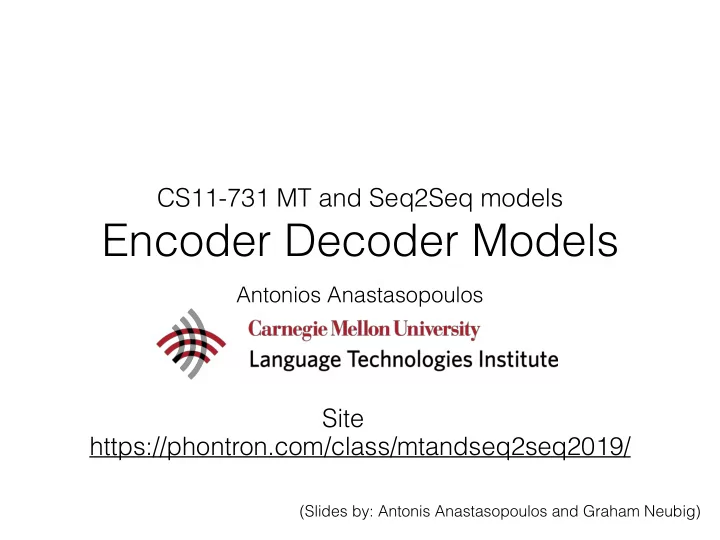

CS11-731 MT and Seq2Seq models Encoder Decoder Models Antonios Anastasopoulos Site https://phontron.com/class/mtandseq2seq2019/ (Slides by: Antonis Anastasopoulos and Graham Neubig)
Language Models • Language models are generative models of text s ~ P(x) “The Malfoys!” said Hermione. Harry was watching him. He looked like Madame Maxime. When she strode up the wrong staircase to visit himself. “I’m afraid I’ve definitely been suspended from power, no chance — indeed?” said Snape. He put his head back behind them and read groups as they crossed a corner and fluttered down onto their ink lamp, and picked up his spoon. The doorbell rang. It was a lot cleaner down in London. Text Credit: Max Deutsch (https://medium.com/deep-writing/)
Conditioned Language Models • Not just generate text, generate text according to some specification Input X Output Y ( Text ) Task Structured Data NL Description NL Generation English Japanese Translation Document Short Description Summarization Utterance Response Response Generation Image Text Image Captioning Speech Transcript Speech Recognition
Formulation and Modeling
Calculating the Probability of a Sentence I Y P ( X ) = P ( x i | x 1 , . . . , x i − 1 ) i =1 Next Word Context
Conditional Language Models J Y P ( Y | X ) = P ( y j | X, y 1 , . . . , y j − 1 ) j =1 Added Context!
(One Type of) Language Model (Mikolov et al. 2011) <s> I hate this movie LSTM LSTM LSTM LSTM LSTM predict predict predict predict predict I hate this movie </s>
(One Type of) Conditional Language Model (Sutskever et al. 2014) Encoder kono eiga ga kirai </s> LSTM LSTM LSTM LSTM LSTM I hate this movie LSTM LSTM LSTM LSTM argmax argmax argmax argmax argmax </s> I hate this movie Decoder
How to Pass Hidden State? • Initialize decoder w/ encoder (Sutskever et al. 2014) encoder decoder • Transform (can be different dimensions) encoder transform decoder • Input at every time step (Kalchbrenner & Blunsom 2013) decoder decoder decoder encoder
Methods of Generation
The Generation Problem • We have a model of P(Y|X), how do we use it to generate a sentence? • Two methods: • Sampling: Try to generate a random sentence according to the probability distribution. • Argmax: Try to generate the sentence with the highest probability.
Ancestral Sampling • Randomly generate words one-by-one. while y j-1 != “</s>”: y j ~ P(y j | X, y 1 , …, y j-1 ) • An exact method for sampling from P(X), no further work needed.
Greedy Search • One by one, pick the single highest-probability word while y j-1 != “</s>”: y j = argmax P(y j | X, y 1 , …, y j-1 ) • Not exact, real problems: • Will often generate the “easy” words first • Will prefer multiple common words to one rare word
Beam Search • Instead of picking one high-probability word, maintain several paths
Sentence Embedding Methods
Sentence Embeddings from larger context: Skip-thought Vectors (Kiros et al. 2015) • Unsupervised training: predict surrounding sentences on large-scale data (using encoder- decoder) • Use resulting representation as sentence representation
Sentence Embeddings from Autoencoder (Dai and Le 2015) • Unsupervised training: predict the same sentence
Sentence Embeddings from Language Model (Dai and Le 2015) • Unsupervised training: predict the next word
Sentence Embeddings from larger LMs ELMo (Peters et al. 2018) • Bi-directional language models • Use linear combination of three layers as final representation Finetune the weights of the linear combination on the downstream task
Sentence Embeddings from larger LMs using both sides: BERT (Devlin et al. 2018)
Recommend
More recommend